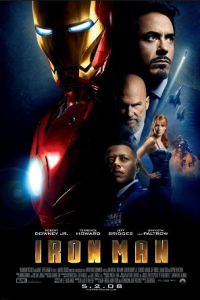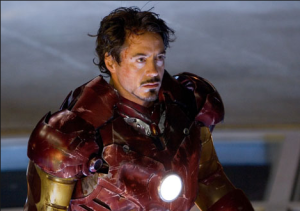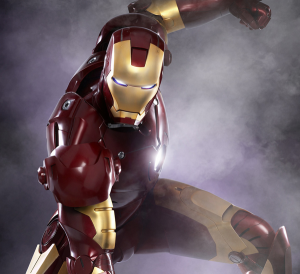
We truly live in the golden age of Marvel movies. In the past six years Marvel Studios (and now Disney) have set the standard for comic-based films, and racked up some of the highest-grossing hits of all time.
This year, the company proved how golden it really is with Guardians of the Galaxy, a film featuring a talking raccoon and his friend, the tree. On paper, that’s laughable. This movie shouldn’t have worked; the concept is so far removed from The Avengers that it conjures up memories of Howard the Duck (who even made a cameo).
But as I sit here typing this, Guardians has the designation of being 2014’s top grossing picture in the U.S.
It’s a wild success story that no one could have predicted — certainly I didn’t — back in 2008 when Marvel Studios released its first film: Iron Man.
As I detailed in my reviews of Superman and Spider-Man 3, I was a Marvel Comics fan in my teen years. At my peak I had several thousand comic books; long boxes stuffed with popular titles like Spider-Man, X-Men, and The Incredible Hulk, as well as Darkhawk, Ravage 2099, and Fantastic Four. Conspicuous perhaps by his absence, I didn’t own a single issue of Iron Man.
The character did make appearances in many comics I owned. Massive crossovers such as Secret Wars prominently featured the Armored Avenger. Yet none of those appearances made me feel like picking up an Iron Man comic. A businessman who pretends to be his own bodyguard in a suit of armor? The concept sounded pretty cheesy. The suit’s design, a garish red and yellow, also was a turnoff. He could fly. He could shoot lasers from his hands. And? Why would I want to read about that?
More, why would I want to see a movie about that?
The arm-chair studio moguls online and in magazines like Entertainment Weekly seemed to agree with me. Phrases like “B-list superhero (at best)” were used to describe Iron Man. It is hard to believe now, but just seven short years ago Iron Man had virtually no name recognition among the common public. Marvel had sold the movie rights to many its most well-known superheroes, including Spider-Man, Hulk, Wolverine and the X-Men, and those characters had gone on to star in their own pictures. Even other B-listers like Daredevil, Blade, and Ghost Rider had been picked up by other studios. What did Marvel have left?
They had Captain America, a man out-of-time goody-two-shoes. They had Thor, a Norse god that may have been even less well-known in his comic incarnation than Iron Man. They had The Incredible Hulk, who had a good history but a recent box-office disappointment thanks to Ang Lee’s Hulk. And they had Iron Man.
Yet Marvel had a vision. More, they had a plan. They didn’t release one film in 2008, they released two. They let it be known immediately that they were going to do on screen what they had done in their comics: create a shared universe where characters would cross over. The end game was announced before Iron Man was in theaters, Marvel wanted to assemble The Avengers.
I thought it was crazy talk. While, thanks to Harry Potter and Lord of the Rings it had become more common to have sequels in production, or even entirely filmed, before the first film was released. Even those seemed risky though, with pundits noting Lord of the Rings could have bankrupted New Line Cinema. Yet here Marvel Studios was going this route for its first features.
Iron Man didn’t excite me, but Marvel’s strategy sure got my attention. It was audacious, it was bold, and it was risky. I admired them before I ever saw a frame of the film.
Even crazier — they hired Robert Downey, Jr. to play Iron Man/Tony Stark. If you’ll recall, in the late 90s and early 2000s, Downey had a fairly toxic reputation in Hollywood. His well-publicized battle with addiction and his prison stints had branded him as unreliable. Worse, he was uninsurable — no company would put up a bond for the actor lest he again be arrested and his filmed scenes became unusable.
Despite his off-screen troubles, I had always been a fan of Downey. While I’d seen him in Weird Science and Back to School he first really caught my eye as someone to watch in The Pick-Up Artist, a film in which Downey is the only redeeming quality. I followed him for many years with Less Than Zero, Chances Are, Air America, hell I even watched Soapdish because he was in it. But two roles really defined Downey for me: his 1992 Oscar-nominated lead in Chaplin, and his role as a tabloid TV reporter in Natural Born Killers. But the more public his personal troubles became the more I felt he was an actor on the decline. I was really saddened by this — the man could act! From Two Girls and a Guy to U.S. Marshals to Kiss Kiss Bang Bang, I’d always been captivated by him.
That he was the star of Iron Man had me both worried and excited. On the one hand it seemed like on-the-nose casting — if I knew one thing about the Tony Stark character in comics it was that he was an alcoholic; if most people knew Downey for only one thing it was for his substance abuse problems.
The trailers with the rocking Black Sabbath track, Downey’s quick quips, the great action, and the effects — the film looked better than I expected; better than it deserved to look. Plus, rumors spread like wildfire that the film would include a cameo by Samuel L. Jackson as S.H.I.E.L.D. boss Nick Fury. By the time Iron Man was released, my curiosity was piqued.
Still, I was more interested in the second of Marvel’s one-two summer punch: The Incredible Hulk. I was a Hulk fan, he was the hero with name recognition; plus it had Edward Norton, an actor I believed was every bit as talented as Downey. But until Hulk came out I thought Iron Man could help me pass the time.
My expectations were low, but I was still there opening night to see Iron Man. I even drove 90 minutes to the closest new-fangled digital projector in the area.
The film, in short, rocked. I never expected to have so much fun in a superhero film. Movies like Blade, X-Men, and Batman Begins had seemed to say there was only one way to make a comic book movie, and that’s deadly serious. Iron Man eschewed that attitude with the flippant irreverence I’d expect from its main character. The movie did have its serious scenes, but the majority of the picture was filled with a kinetic energy and a constant sense of fun. I walked into the theater not getting Iron Man’s appeal; I walked out an Iron Man fan.
This was bolstered by Downey’s now-iconic performance. I couldn’t take my eyes off him. His jokes, his charisma, he owned this film. His line, “I am Iron Man,” was 100 percent accurate, for I couldn’t imagine this movie without him. Given the wide range of roles I’ve seen Downey portray I am hesitant to call this his best performance ever, but it is my favorite (with his 2008 follow-up Tropic Thunder a very close second).
Iron Man even brought Now Playing Podcast out of a brief retirement in 2008, and we followed up that short review with an even more extensive breakdown of the film for our Avengers Retrospective Series in 2012.
Yet, despite my love of the movie, I still thought Marvel’s overall strategy was ill-formed. Iron Man did well, Hulk did not. More, the only superhero film people seemed to remember from 2008 was Christopher Nolan’s The Dark Knight — a film that was more than a blockbuster, it was a cultural touchstone.
In 2008 it really seemed Marvel had lost the battle. More, they had no movies planned for 2009. Iron Man was a big enough hit to keep the wheels turning for Iron Man 2 in 2010 but I never thought Marvel could go the distance. Avengers seemed like a pipe dream.
Again, I bet wrong. Iron Man 2 built on the brand in 2010, and the following year saw two more Marvel films, Thor and Captain America: The First Avenger. Both did respectable business, but neither broke the $200 million domestic mark to be qualified as a blockbuster. They didn’t need to; Marvel was playing the long game, they were building a brand.
It paid off — big time. The Avengers took the world by storm. It almost seemed a rematch of Marvel versus DC as, that same year, Nolan returned with The Dark Knight Rises. Iron Man once again faced Batman, but this time Stark brought his friends and when 2012 ended it was The Avengers that had become the benchmark for comic book movies. Sorry, Batman.
Marvel Studios’ brazen gambit paid off in spades. Not only has the company become an unstoppable movie juggernaut, they have expanded their cinematic universe to weekly network television, to four different Netflix series’, and even drawn plans for up to three movies per year in the future.
Other studios now desperately try to ape Marvel’s success. After trying for 20 years to get Batman and Superman on screen together, next year finally brings us Batman v Superman: Dawn of Justice, with a list of superheroes that include Wonder Woman, Cyborg, and — according to rumor — Aquaman, the Flash, and others. DC is now playing catch-up to Marvel.
Even other studios with Marvel properties have tried to follow this formula, though to less success. The same year The Avengers was released Sony tried to build its own multi-chapter story with The Amazing Spider-Man. This year they announced that a Spidey universe of films is coming, including two spin-offs featuring villains — Sony is now grasping for whatever characters to which they hold rights. At 20th Century Fox, studio executives also bet big-time on their X-Men franchise, bringing back original director Bryan Singer to revitalize the series. The Marvel Studios tactic of ending each film with a “stinger” to tease the next picture is now so commonplace, audience members are afraid to leave the theater before the end credits are finished.
Yes, for the past 6 years movies have been following Marvel Studios’ formula. It all started with a big gamble that paid off: Iron Man.
As for me, Iron Man opened a door that had been cracked the year before with Spider-Man 3. The Marvel movies were really an exciting property to follow. My dormant comic fandom was back with a vengeance. Marjorie, knowing my love of Iron Man, bought me my first high-end Marvel collectibles: a Hot Toys “Mech Test” Tony Stark figure, as well as a Kotobukiya Iron Man statue. The door was opened and before long the podcast Marvelicious Toys was launched as a companion piece to Star Wars Action News, focusing specifically on Marvel collecting.
More, Marvel Studios’ films had me wanting to build up to The Avengers. Now Playing Podcast had been following, almost exclusively, the retrospective format in 2009 and 2010, but after seeing Iron Man 2 I pitched to co-hosts Stuart and Jakob the craziest, biggest retrospective yet: every Marvel movie ever. Up until then our series’ had all been of manageable length of a dozen films or less. It took a year of discussion. First, Stuart thought we should only do the six Marvel Studios films. Then he thought we should do the major franchises. Finally he agreed to all theatrical films, and we had started Now Playing’s Complete Marvel Movie Retrospective. Over time I was even able to find a back door — several 1970s TV movies had aired in theaters in foreign countries.
It put Now Playing on a path to greater success, as described in my review of Howard the Duck — our first review in that very long series.
Yet while I still ride the high Iron Man gave me in 2008, bolstered regularly by a new “fix” from Marvel Studios, I do wonder how long this will last. Movies are defined by trends; after Star Wars every studio fast-tracked their space films, but by the mid-80’s those had become passé; after Gremlins any script with tiny attackers, from Ghoulies to Critters was given the green light. The cases of Hollywood me-too-ism are legion, but they all have one thing in common: they end when the next big thing comes along.
I often ruminate on what that next trend will be, and when audiences will tire of the serialized cinema storytelling and prefer movies that provide a singular experience with no “to be continued…” at the end. I have no doubt that day will come, but I think we’re in for many more years of the Marvel Age of cinema before we get there.
Tomorrow — 2009!
Arnie is a movie critic for Now Playing Podcast, a book reviewer for the Books & Nachos podcast, and co-host of the collecting podcasts Star Wars Action News and Marvelicious Toys. You can follow him on Twitter @thearniec


